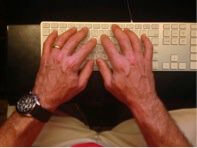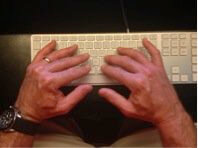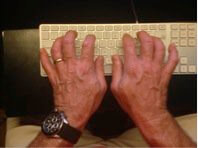Keyboarding and mousing may not be considered strenuous activities, but if done incorrectly over time, they can damage the wrist and hand as surely as a nasty fall onto concrete. Office workers can spend eight or more hours keyboarding every day and, unfortunately, many of them are doing it wrong. Others spend less time at the computer but they can develop some degree of injury as well.
A common misconception many have is that computer use causes carpal tunnel syndrome (CTS). However, evidence for a direct connection between the two is minimal. The reality is that computer misuse causes CTS. And most people don’t know that it is very preventable.
Most employees are trained to use their computer for their job, but not how to interact with it in a mechanical sense. Not every work area is ergonomically designed or set up for the job in a way that does not put the employee at risk for overuse injury. And even when people know the proper guidelines and have the right workspace, bad habits often creep back in due to fatigue and inattention.
If you’re not working properly at the keyboard, chances are the first sign will be back pain, neck pain, soreness or stiffness. Eventually, the pains may extend into the shoulders, forearms, wrists, and hands. Numbness and tingling might suggest nerve problems. Symptoms from arthritis may be exacerbated by repetitive workstation activities including keyboarding, and tendinitis may occur as well.
Over the counter or prescription-strength nonsteroidal anti-inflammatory drugs (NSAIDs) such as ibuprofen or naproxen certainly, have their place in initial treatment strategies. Additional splints and occupational therapy can be helpful as well. But managing symptoms once they start is only a small part of the story. Prevention is a far more important.
The most important thing about computer-related wrist injury is to avoid it. It’s been said, “Knowledge is power.” Consider yourself a professional keyboard athlete, and like all athletes, information about training and developing the mindset to succeed are key.
There are some practical things you can do, and while you read through these, remember that a major emphasis is placed on putting your wrist into a position that avoids pressure on them, and minimizes bending of the wrists up or down. And it’s this position that reduces the pressure on the carpal tunnel. Another emphasis is on posture and positioning the neck, shoulders, and elbows comfortably so as to protect you from overuse and repetitive strain injuries.
Smartphone use also causes wrist and hand pain: 9 ways to prevent it
Tips to avoiding carpal tunnel from using your computer
Sitting at your desk
- Sit upright with your head and torso aligned vertically, your weight evenly dispersed in the chair and buttocks at the back of the seat.
- Position the screen at least 20 inches in front of you, with the screen at eye level.
- Adjust chair height or keyboard level so that your hands are slightly below your elbows. With your shoulders relaxed, start with your hands folded comfortably in your lap with your elbows flopped loosely at your side.
Using your keyboard

Raise your hands up,
but keep them below the level of your elbows
- The back of the wrists should be flat or only slightly bent back.
- Don’t rest your arms on chair arm rests while keyboarding; adjust or remove them if necessary.
- Do not use wrist or palm rests. You should be positioned in a way that’s similar to playing piano… floating above the keyboard. No gel pads for the mouse either.
- The keyboard position should be adjusted to allow for the elbow and wrist positioning described above.

Keep wrists pointed straight

not “pigeon-toed” inward

or “duck-footed” outward
An ergonomic keyboard may be helpful for those who are larger around the chest and mid-section / abdomen, and who might have difficulty getting their hands into the optimal position relative to a traditional keyboard. Without the ergonomic keyboard, having the elbows farther out (because of a larger midsection) might force larger people to improperly place their wrists in a “duck-footed” alignment when sitting at a traditional keyboard.
On the other hand, use of an ergonomic keyboard by those whose chest and abdomen are more slender would not always be advised. In order to keep the wrists properly aligned to an ergonomic keyboard, those individuals might be forced to maintain their elbows away from the body, resulting in cumulative strain to the shoulders, elbows, and wrists.
Using your mouse
- The mouse should be just to the side of the keyboard so that the elbow does not have to leave the side of the body to reach for it.
- Also, the hand should remain below the elbow, and no pressure should be placed on the wrist while using the mouse.
- Get rid of the gel pad.
- There should be only light pressure between the mid-palm of the hand and the mouse, and none on the wrist.
Keep moving
- Take frequent micro-breaks from keyboarding… 5 seconds every 30 minutes in order to stretch overhead, and improve posture.
- Do some filing, making phone calls, and spread out other tasks to get a break from typing.
- Change position from time to time… sway in your seat, rotate your arms, stand up, twist your body, look around.
- Don’t pound the keys or put a stranglehold on the mouse.
- Develop a smooth typing motion without flourishes and jerking movements.
Don’t ignore problems
In the end, attention to body mechanics is extremely important and provides the key to longevity in terms of ability to perform well over time while using a keyboard. But knowing and doing are two different things. Now that you are aware, you need to put these guidelines into practice. Followed carefully, the recommendations outlined above can significantly reduce your risk for injury.
Just being careful and conscientious, however, doesn’t make you unbreakable. If you start to experience wrist discomfort or pain, see a doctor to have it checked out. Too many people try to work through pain or hope it will go away, only to experience things getting worse. It’s easier to correct a problem early on, and we are here to help.

